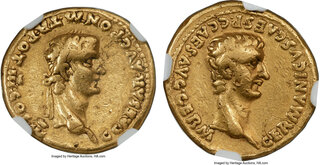Lot description:
Ancients
Gaius (Caligula) (AD 37-41), with Germanicus. AV aureus (19mm, 7.72 gm, 4h). NGC VF 5/5 - 2/5, edge damage. Rome, AD 37-38. C CAESAR•AVG•PON•M•TR•POT•III•III, laureate head of Gaius right / GERMANICVS•CAES•P•C•CAES•AVG•GERM•, bare head of Germanicus right. Calicó 324. RIC I 25. This piece is wonderfully struck, showcasing two distinct portraits of the father and son and the full legends clearly visible on both sides. It was struck on a flan lovely toning and a lustrous, satin-like finish.
Germanicus, the father of Gaius, was the John F. Kennedy of his generation - enormously popular with the Roman masses for his good looks, impeccable genes, attractive family, and wartime heroics. His untimely death only added to his legend. The grandson of Augustus' wife Livia, Germanicus was so named for his father Drusus's spectacular conquests in Germany during the second decade of Augustus' reign. After the Varian disaster of AD 9 had undone most of these conquests, Germanicus took up leadership of a Roman army and rushed to the German frontier to prevent a general collapse. At the death of Augustus in AD 14, the Rhine legions attempted to acclaim Germanicus as Emperor, but he refused the honor and gave his support to his uncle Tiberius. By AD 15, Germanicus had built a formidable army and crossed the Rhine to exact revenge on the treacherous chieftain Arminius, who had led Varus to his doom. Over the course of two excruciatingly difficult campaigns, Germanicus rebuilt Roman prestige and inflicted a seemingly decisive defeat on the Germans at Idistoviso in AD 16. Tiberius, however, recalled him to Rome, allowing eastern Germany to once again slip from Roman control. Germanicus received a rapturous welcome and seemed clearly marked out as heir apparent; however, during a diplomatic mission to the East in AD 19, Germanicus fell ill and died under highly suspicious circumstances. Wags blamed the jealous Tiberius, acting through his agent G. Calpurnius Piso, governor of Syria. A show trial of Piso, which ended in his suicide, failed to alleviate suspicion, and Germanicus' widow Agrippina became the locus of resistance to the regime. She and her sons Drusus and Nero accordingly suffered persecution and death; only the youngest son, Gaius, survived. He, alas, proved a most unworthy son to a great father, but that is another story.
https://coins.ha.com/itm/ancients/roman-imperial/ancients-gaius-caligula-ad-37-41-with-germanicus-av-aureus-19mm-772-gm-4h-ngc-vf-5-5-2-5-edge-damage/a/3115-31053.s?type=DA-DMC-CoinArchives-WorldCoins-3115-05082024
HID02906262019
© 2024 Heritage Auctions | All Rights Reserved
Estimate: 30000-40000 USD |  |